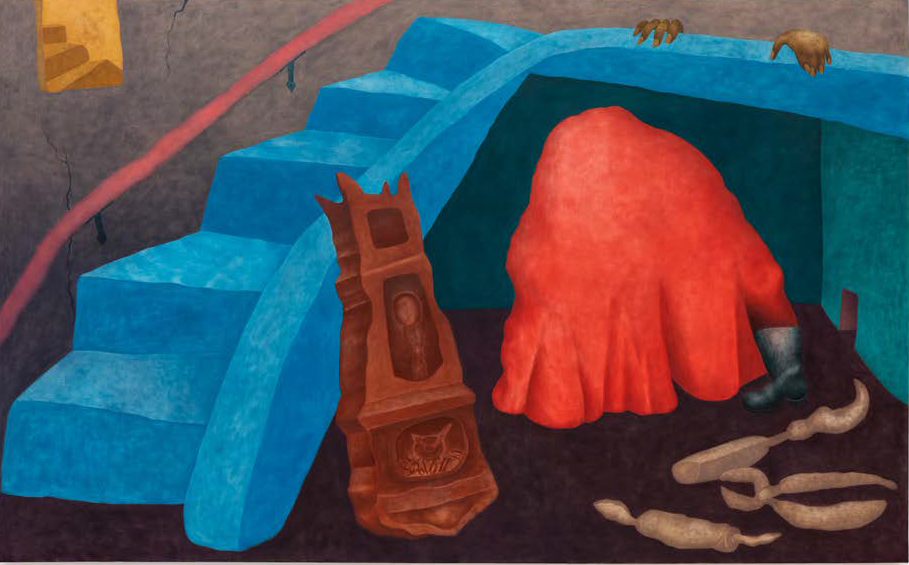 'Sense Memory' by Ginny Casey. Courtesy of the artist and Nino Mier Gallery.
'Sense Memory' by Ginny Casey. Courtesy of the artist and Nino Mier Gallery.
‘Trap Door’ & ‘Black Elf’ by Ginny Casey & Ulrich Wulff @ Nino Mier Gallery
Ginny Casey presents us with a surrealist motif in her Nino Mier Gallery opening Trap Door. Each of her compositions presents a clever diorama of what can be described as “set-pieces” of human objects and in a positively less cryptic style than what is prototypically Surrealist. We do not, for instance, find the bizarre and the confusing pressure-cooker of a Dalí, for example. Ms. Casey is not keen on a forceful expansion of our concepts of the humane, including the mischievous play of landscape by the latter artist. Her gentleness allows us to more calmly appreciate her whimsical forms without a defensiveness to any sense of ambiguous weirdness which typifies Surrealism.
This whimsy also includes her play in perception, which again is a welcoming entrance for our subjectivity. Once warmly framed, our subjectivity can appreciate the clever metaphors associated with the titles. Stunted Developments reflects incompleteness to human categories, not simply human forms, with ceramic cracks suggesting the evanescence of human conduct. How rare, it is, for there to be sustained human action – such duty is lacking, which may be a meditation on the habit of excellence required to stamp a semblance of permanence by a human life. A Place of Our Own, as another witty example, breathes a childhood story nostalgia of the old woman who lives in a shoe, yet aspirationally akin to first-time homeowner dreams.
Yet in all her compositions there are suggested residencies with labyrinthine architecture but with the hosts being mostly absent, sansa few goblin-esque fingers which are tantalized by the precious belongings left unattended. The addition of these creepy crawly fingers implicates a sense of fantasy; a sense of danger in the unknown spaces presented; and yet, also still, a sense of the humane with the taciturn covetousness of these personal belongings which would be found in an estate sale. It is this expression of sentimentality in her works which archetypical Surrealism fails to invoke with its preoccupation on eccentrically charged imagination. This sentimentality necessitates such intimacy in her settings to breathe warmth and coziness (ameliorated by her muted oil luminosity on the canvas) contra bewilderment as one might assert as the raison d’etre of 20th century Surrealism.
Meanwhile, Mr. Ulrich Wulff demonstrates another terrific example of a felicitous innocence to painting. His crude childish forms may ostensibly be disappointing to an individual with a preconception of fine artistry, of one who imagines a more serious and sacral template as the prerequisite. And yet, this assumes childish imagination is not! what may appear to be a lack of refinement is abundantly compensated for with purity, enabling a resonant clarity of beauty which is the historical exercise of Western fine art. Beauty can be imagined to be silly, and with this elastic conception we are drawn away from petty distractions of adulthood towards unadulterated forms of what can possibly be – stretching the human imagination. This silliness is best represented by the excessively rudimentary eyeballs of what can be imagined to be the outstretched efforts of a childhood imagination.
Mr. Wulff is quite daring to be so willfully constrictive in his shapes, to represent the childish perspective of planar forms and a fastidiousness to creating a panoply of creatures, with a similarly childish disinterest in fomenting any sense of dialogue. This is akin to a fantastical zoo rather than a drama; an ingenious continuity of the artistic aim as we can intuit that simple sense of wonder which is being drawn out, rather than tension. And it is doubtless that this daring effort at wonder is achieved so basically.

